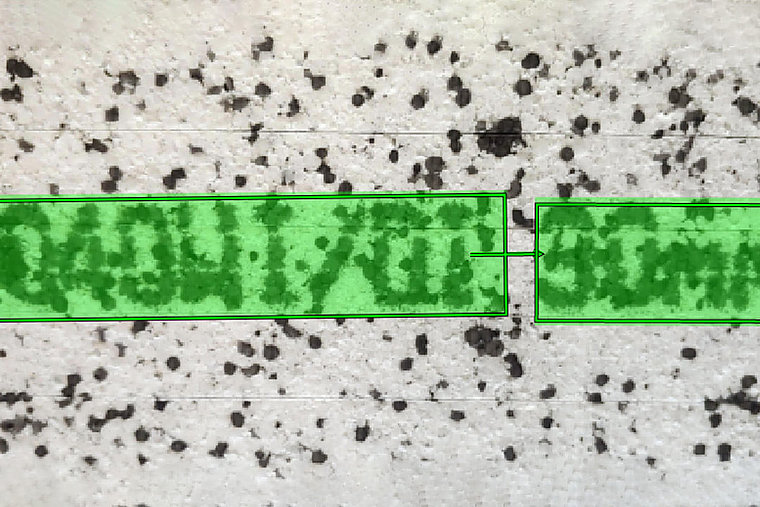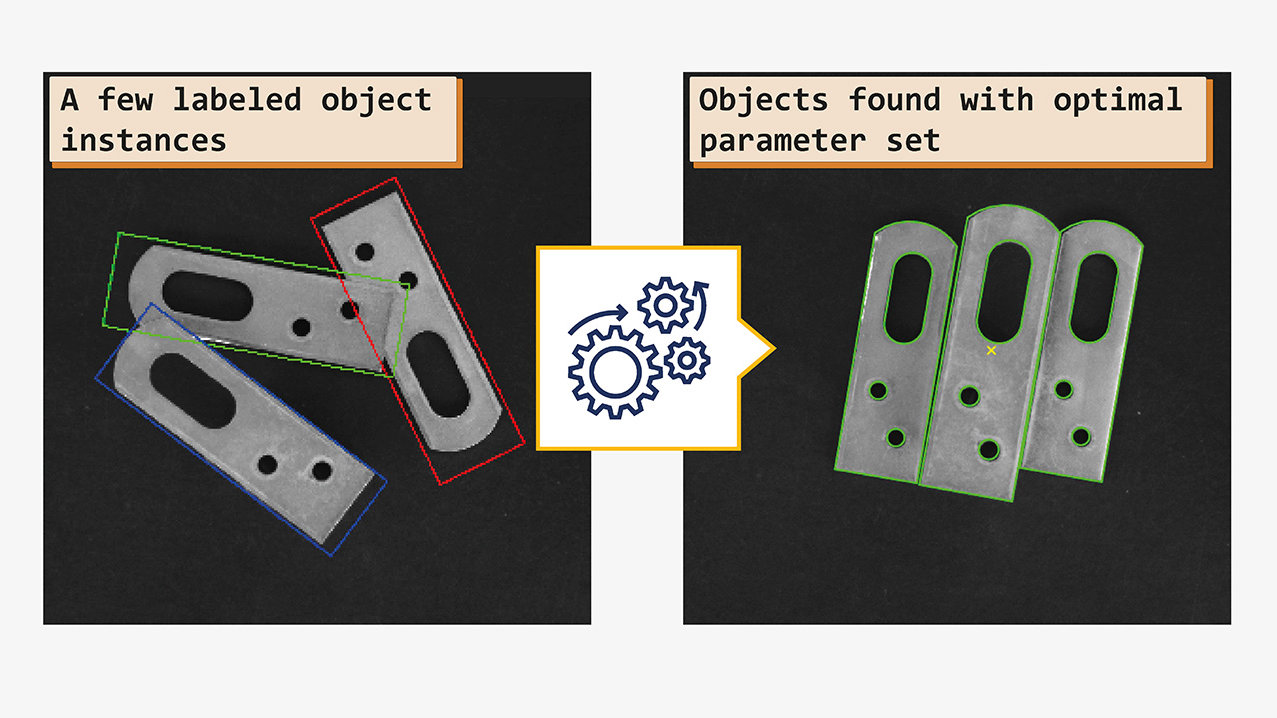MVTec
HALCON Steady 24.11

HALCON 22.11 opens up completely new application possibilities with the detection of logical anomalies in images. This is the further development of the deep learning technology anomaly detection. Until now, it was possible to detect local, structural anomalies. The new "Global Context Anomaly Detection" is a one-of-a-kind technology, which is able to "understand" the logical content of the entire image. Just like HALCON's existing anomaly detection, the new "Global Context Anomaly Detection" only requires "good images" for training, eliminating the need of data labeling. This technology makes it possible to detect entirely new variants of anomalies like missing, deformed, or incorrectly arranged components. It opens up completely new possibilities: For example, the inspection of printed circuit boards in the semiconductor production or the inspection of imprints.

Highlights
- HALCON is your solution for the full range of applications in the field of machine vision
- Enabler of the Industrial Internet of Things (aka Industry 4.0)
- Large imaging library of more than 2,100 operators
- Integrated development environment (IDE) for machine vision: HDevelop
- Huge range of features including deep learning
- Easy programming in C, C++, C#, Python, and Visual Basic .NET
- Available for a multitude of platforms
- Support of multi-core and multiprocessor computers
- High performance through utilization of state-of-the-art instruction sets and GPU Acceleration
- Support of hundreds of industrial cameras, frame grabbers, and all common vision standards
Features
- Revolutionary software for 3D machine vision
- Matching to find even rotated or partly occluded objects
- Blob analysis with more than 50 shape and gray value features
- High-accuracy measuring
- Huge range of latest deep learning technologies
- Optical character recognition and verification (OCR/OCV)
- Arbitrarily shaped regions of interest (ROIs) for significant flexibility and speed
- Detection of lines, circles, and ellipses with an accuracy of up to 1/50 pixel
- Extremely fast morphology
- Color image processing and hyperspectral imaging
- Processing of extremely large images (more than 32k x 32k)
- Image sequence processing (e.g., for surveillance tasks)
- Accurate 3D camera calibration

Major features of HALCON 24.11
In this release the users can look forward to groundbreaking technologies and improvements. With HALCON 24.11, we are focusing on even better AI, specifically deep learning algorithms. Among other features, users can now detect and evaluate unexpected behavior in deep-learning-based classification.

Deep Counting
With Deep Counting, a feature is available to customers as of HALCON 23.05 that can be used to count a large number of objects quickly and robustly as well as to detect their position. The deep-learning-based technology offers significant advantages over existing machine vision methods: The feature can be deployed very quickly, since only very few objects need to be labeled and trained – both steps can be easily done within HALCON. The technology provides reliable results even for objects of highly reflective and amorphous material. With Deep Counting large numbers of objects such as glass bottles, tree trunks, or food can be counted.
Training for Deep OCR – Detection
Deep OCR reads texts in a very robust way, even regardless of their orientation and font. For this purpose, the technology first detects the relevant text within the image and then reads it. With HALCON 23.05, it’s now also possible to fine-tune the text detection by retraining the pretrained network with application-specific images. This provides even more robust results and opens new application possibilities. For example: the detection of text with arbitrary printing type or unseen character types as well as an improved readability in noisy, low contrast environments.


Training for 3D Gripping Point Detection
3D Gripping Point Detection can be used to robustly detect surfaces on any object that is suitable for gripping with suction. In HALCON 23.05 there is now the possibility to retrain the pretrained model with own application-specific image data. The grippable surfaces are thus recognized even more robustly. The necessary labeling is done easily and efficiently via the MVTec Deep Learning Tool.
Easy Extensions Interface
With the help of HALCON extension packages the integration of external programming languages is possible. The advantage for customers: Functionalities that go beyond pure image processing can thus be covered by HALCON. In HALCON 23.05, the integration of external code has become much easier with the Easy Extensions Interface. This allows users to make their own functions written in .NET code usable in HDevelop and HDevEngine in just a few steps, while benefiting from the wide range of functionalities offered by the .NET framework. Even the data types and HALCON operators known from the HALCON/.NET language interface can be used. This increases both the flexibility and the application possibilities of HALCON.

MVTec license server cloud ready
With HALCON 23.11, customers have an additional "cloud-ready" variant of the license server at their disposal. This now makes it possible to license HALCON in the environments of commercial cloud providers as well as in enterprise-owned cloud setups without the need for a hardware dongle, solely through a network connection. This means that HALCON can now be easily licensed across all cloud solutions. By using HALCON in the cloud, customers can easily benefit from the new possibilities offered by machine vision in the cloud.

Structured light 3D reconstruction
In HALCON 23.11, the structured light model has been enhanced: besides deflectometry, it now also provides precise 3D reconstruction for diffuse surfaces in short cycle times. This enhancement gives users the flexibility to develop their own application-specific 3D reconstruction systems using a pattern projector and a 2D camera. The feature is particularly suitable for applications where precise spatial representations are required. As a result, the technology is suitable for the optimization of manufacturing processes, quality control, and the precise measurement of various surfaces.


Multi-Label Classification
In the new HALCON version, customers now have access to multi-label classification, a new deep learning method that allows the recognition of multiple different classes on a single image. Such classes can encompass various properties of the objects within the image, for example defect types, color, or structure. In practice, this method can, for instance, reveal the presence of different types of defects in an image, allowing a more detailed classification. Compared to other methods, this deep learning method is faster in processing and the effort for labeling is also lower.
Further Improvements
In HALCON 23.11, a number of improvements for existing methods and technologies were implemented. For Global Context Anomaly Detection, a method for detecting complex anomalies, the underlying neural network has been further optimized. This improves the accuracy of anomaly detection without increasing hardware requirements or execution time. In addition, HALCON now utilizes the latest NVIDIA® CUDA® toolkit. This provides users with the opportunity to choose from an even greater range of AI accelerators. For example, the new NVIDIA Jetson OrinTM modules are now supported as well. Finally, several performance optimizations of HALCON's core technologies have been implemented in HALCON 23.11. For example, template matching operators (NCC Matching) now run up to 80% faster on Arm-based systems.
Extended parameter estimation for Shape Matching
HALCON 24.05 introduces the first iteration of the extended parameter estimation for Shape Matching. With its subpixel accuracy, Shape Matching finds objects robustly and accurately in real-time, even in the most challenging situations. Thanks to the extended parameter estimation, manual parameter adjustments will soon be a thing of the past. Using multiple annotated images, users can now easily optimize for maximum online speed while keeping robustness through automated parameter tuning. Users thus benefit from a faster implementation of shape matching applications, even without specialized expertise. Shape Matching has never been easier!


Bar code reader improvements for stacked bar codes
The bar code reader for GS1 DataBar Expanded Stacked codes has been improved in HALCON 24.05. Depending on the application, customers can expect significant improvements to their decoding rates. This will especially benefit industries such as logistics, retail, and manufacturing, where stacked bar codes are an essential means of tracking and tracing goods.
3D improvements & enhancements: Importing 3D object models from the STEP format
Starting with version 24.05, HALCON supports the STEP (Standard for the Exchange of Product Data) file format, the industry standard for 3D CAD data. Customers can now seamlessly load STEP CAD data directly into a HALCON 3D object model without any intermediate steps or conversions. The STEP format is supported by most common CAD programs, increasing interoperability and efficiency, because models for 3D matching can be taken directly from the planning data in the CAD software.


New version of the OpenVINO™ Toolkit AI² plug-in
Parallel to the HALCON 24.05 release, a new version of the OpenVINO Toolkit AI² plug-in will be released. This update uses the latest LTS version of the Intel® Distribution of OpenVINO™ Toolkit, ensuring compatibility with the latest Intel hardware and boosting the inference performance of deep learning applications. Notably, the new plug-in version enhances support for Intel’s 13th generation of Core processors, leading to improved inference performance. In addition, customers can now also utilize Intel’s discrete graphics cards for inference, providing greater flexibility in selecting the appropriate hardware for their application.
Speedups and further improvements
HALCON 24.05 also includes several performance optimizations for various core technologies. For example, unwarping byte images using a vector field is now up to 285 % faster on AVX2-capable Intel CPUs. The operator map_image is now up to 25% faster as well. In addition, HALCON 24.05 provides adjustments to many operators to address performance impacts resulting from Intel's resolution of the "Downfall" security vulnerability.

Out of Distribution Detection (OOD) for Classification
new HALCON feature makes it easy to recognize unexpected behavior caused by incorrect classifications in production. Thus, users can take appropriate measures, such as stopping the machine, in a targeted and efficient manner. When using a deep learning classifier, unknown objects are assigned to one of the classes that the system has learned. This can lead to problems if, for example, the defects or objects themselves are of a type that has never occurred before. The new deep learning feature “Out of Distribution Detection (OOD)” indicates when an object is classified that was not included in the training data. For example, this could be a bottle with a green label if the system was only trained on bottles with red or yellow labels. In such cases, HALCON provides the message “Out of Distribution” together with an OOD score that indicates how much the deviation from the trained classes is.
The OOD score can also be useful when expanding deep learning models with new training images by indicating which of the new images will have the greatest value for the new model. For example, a high OOD score for a new training image indicates a greater deviation from the images already in the network – this means a higher information content and, therefore, greater value for the training.
Improved Shape-based Matching
The new HALCON version makes the “Shape-based Matching” feature, used in many applications, more user-friendly. This technology is used to find objects fast, accurately, and precisely. HALCON 24.11 includes the new patent pending "Extended Parameter Estimation" for this purpose. This allows parameters to be estimated with greater granularity, which significantly speeds up execution in some applications. “Extended Parameter Estimation” enables this estimation also for users without in-depth machine vision expertise.


Optimized QR code reader
The performance of HALCON's QR Code Reader has been significantly increased. This is particularly evident under difficult conditions, for example, when many codes need to be found in the image area or many textures in the image complicate the detection. The recognition rate has been increased and the evaluation time has been significantly reduced in demanding scenarios.
Deep 3D Matching
With this feature, HALCON 24.11 contains a deep-learning-based market innovation for the 3D vision sector, especially for bin-picking and pick-and-place applications. This feature is particularly robust in determining the exact position and rotation of a trained object and is characterized by very low parameterization effort and fast execution time. Depending on the accuracy requirements, one or more cost-efficient standard 2D cameras can be used to determine the position. Training is performed exclusively on synthetic data generated from a CAD model. Further training is therefore not required.
Customers can already run this feature in HALCON 24.11 – to train the model and evaluate applications, they can contact MVTec at any time. Training and evaluation within HALCON will follow in the next release.
HALCON’s GigE Vision interface supports RoCEv2
With this release, HALCON's GigE Vision interface supports the RoCEv2 network protocol, which enables increased performance in image transmission.
Improved HALCON Progress edition
HALCON Progress is now fully compatible with the HALCON Steady edition. Progress users can now collaborate with Steady users on the same projects. Additionally, HALCON Progress users will receive the same maintenance updates as HALCON Steady users. In the future, switching from Steady to Progress will simply require exchanging the license file.

AGRICULTURE & FOOD
Identification of natural products,automated fruit picking and sorting, or fill level measurement: HALCON is a technology for producers and packagers alike to achieve efficient and consistent production and keep up with the ever-changing demands of consumers.

AUTOMOTIVE & ROBOTICS
Determine the 3D pose of objects, extract 3D data for bin picking or robot path planning: HALCON's unique 3D vision techniques open new possibilities for numerous automotive and robotics applications.

LOGISTICS & PACKAGING
Quality control, completeness inspection, identification, or bar & data code reading: HALCON offers outstanding methods in all areas of logistics and packaging.

ELECTRONICS & SEMICONDUCTORS
Precise assembly, surface inspection or defect detection during the entire manufacturing process: With HALCON, system manufacturers are fully equipped to implement advanced processes at reduced costs.
HALCON Editions
|
Progress |
Steady |
|
|
